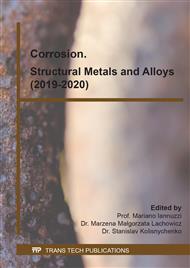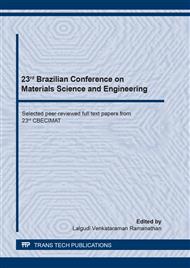p.385
p.390
p.395
p.401
p.407
p.412
p.418
p.424
p.430
Study of Corrosion of AA 3003 Aluminum in Biodiesel, Diesel, Ethanol and Gasoline Media
Abstract:
The contact between fuels and various metals used in vehicles make them susceptible to corrosion. Aluminum is a metal widely used in automotive components owing to its corrosion resistance as well as mechanical properties. The ABNT 14359 standard establishes a method for determining fuel corrosion; however, it is restricted to copper and fossil fuels. In this standard, corrosion is assessed qualitatively by visual comparison of patterns, which can lead to uncertain results. The methodology used in this study involves the immersion of metallic materials in fuels for a specific period of time for further analysis by scanning electron microscopy (SEM), and electrochemical analysis by electrochemical impedance spectroscopy (EIS) and anodic potentiodynamic polarization (APP). The results indicated that aluminum alloy AA 3003 is suitable for use in the production of vehicle components that will be in contact with biodiesel, diesel, ethanol, or gasoline, since no serious case of corrosion occurred.
Info:
Periodical:
Pages:
407-411
Citation:
Online since:
October 2020
Keywords:
Price:
Сopyright:
© 2020 Trans Tech Publications Ltd. All Rights Reserved
Share:
Citation:




